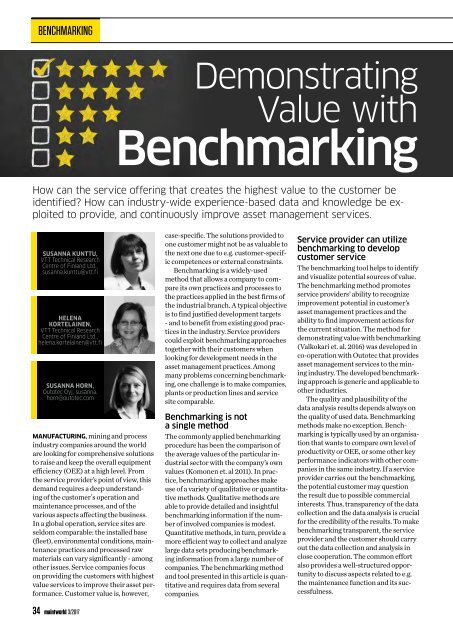Maintworld 3/2017
In this issue: Using Technology and Innovation to Manage Mega-Maintenance Challenges Identify the Root Cause of a Misalignment Condition Elements of a Good Preventive Maintenance Program
In this issue:
Using Technology and Innovation to Manage Mega-Maintenance Challenges
Identify the Root Cause of a Misalignment Condition
Elements of a Good Preventive Maintenance Program
Create successful ePaper yourself
Turn your PDF publications into a flip-book with our unique Google optimized e-Paper software.
BENCHMARKING<br />
Demonstrating<br />
Value with<br />
Benchmarking<br />
How can the service offering that creates the highest value to the customer be<br />
identified? How can industry-wide experience-based data and knowledge be exploited<br />
to provide, and continuously improve asset management services.<br />
SUSANNA KUNTTU,<br />
VTT Technical Research<br />
Centre of Finland Ltd.,<br />
susanna.kunttu@vtt.fi<br />
HELENA<br />
KORTELAINEN,<br />
VTT Technical Research<br />
Centre of Finland Ltd.,<br />
helena.kortelainen@vtt.fi<br />
SUSANNA HORN,<br />
Outotec Oyj, susanna.<br />
horn@outotec.com<br />
MANUFACTURING, mining and process<br />
industry companies around the world<br />
are looking for comprehensive solutions<br />
to raise and keep the overall equipment<br />
efficiency (OEE) at a high level. From<br />
the service provider’s point of view, this<br />
demand requires a deep understanding<br />
of the customer´s operation and<br />
maintenance processes, and of the<br />
various aspects affecting the business.<br />
In a global operation, service sites are<br />
seldom comparable: the installed base<br />
(fleet), environmental conditions, maintenance<br />
practices and processed raw<br />
materials can vary significantly - among<br />
other issues. Service companies focus<br />
on providing the customers with highest<br />
value services to improve their asset performance.<br />
Customer value is, however,<br />
34 maintworld 3/<strong>2017</strong><br />
case-specific. The solutions provided to<br />
one customer might not be as valuable to<br />
the next one due to e.g. customer-specific<br />
competences or external constraints.<br />
Benchmarking is a widely-used<br />
method that allows a company to compare<br />
its own practices and processes to<br />
the practices applied in the best firms of<br />
the industrial branch. A typical objective<br />
is to find justified development targets<br />
- and to benefit from existing good practices<br />
in the industry. Service providers<br />
could exploit benchmarking approaches<br />
together with their customers when<br />
looking for development needs in the<br />
asset management practices. Among<br />
many problems concerning benchmarking,<br />
one challenge is to make companies,<br />
plants or production lines and service<br />
site comparable.<br />
Benchmarking is not<br />
a single method<br />
The commonly applied benchmarking<br />
procedure has been the comparison of<br />
the average values of the particular industrial<br />
sector with the company’s own<br />
values (Komonen et. al 2011). In practice,<br />
benchmarking approaches make<br />
use of a variety of qualitative or quantitative<br />
methods. Qualitative methods are<br />
able to provide detailed and insightful<br />
benchmarking information if the number<br />
of involved companies is modest.<br />
Quantitative methods, in turn, provide a<br />
more efficient way to collect and analyze<br />
large data sets producing benchmarking<br />
information from a large number of<br />
companies. The benchmarking method<br />
and tool presented in this article is quantitative<br />
and requires data from several<br />
companies.<br />
Service provider can utilize<br />
benchmarking to develop<br />
customer service<br />
The benchmarking tool helps to identify<br />
and visualize potential sources of value.<br />
The benchmarking method promotes<br />
service providers’ ability to recognize<br />
improvement potential in customer’s<br />
asset management practices and the<br />
ability to find improvement actions for<br />
the current situation. The method for<br />
demonstrating value with benchmarking<br />
(Valkokari et. al. 2016) was developed in<br />
co-operation with Outotec that provides<br />
asset management services to the mining<br />
industry. The developed benchmarking<br />
approach is generic and applicable to<br />
other industries.<br />
The quality and plausibility of the<br />
data analysis results depends always on<br />
the quality of used data. Benchmarking<br />
methods make no exception. Benchmarking<br />
is typically used by an organisation<br />
that wants to compare own level of<br />
productivity or OEE, or some other key<br />
performance indicators with other companies<br />
in the same industry. If a service<br />
provider carries out the benchmarking,<br />
the potential customer may question<br />
the result due to possible commercial<br />
interests. Thus, transparency of the data<br />
collection and the data analysis is crucial<br />
for the credibility of the results. To make<br />
benchmarking transparent, the service<br />
provider and the customer should carry<br />
out the data collection and analysis in<br />
close cooperation. The common effort<br />
also provides a well-structured opportunity<br />
to discuss aspects related to e.g.<br />
the maintenance function and its successfulness.

















